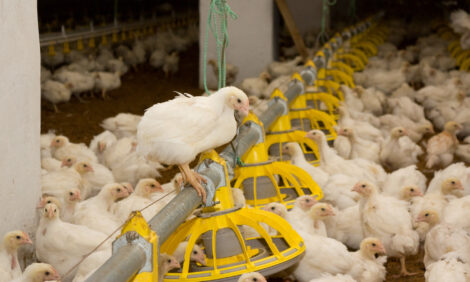



Funding Increased to Combat Disease Threats
GLOBAL - FAO's commitment to fight emerging disease threats in "hotspot" regions worldwide is getting a boost with new funding from the United States Agency for International Development (USAID), the UN agency has announced.FAO reports that the funding, totalling more than $20 million, will support the ongoing US-FAO partnership against H5N1 highly pathogenic avian influenza (HPAI) and a widening focus on potential emerging pandemic threats.
Continuing threat of bird flu
The US assistance will help strengthen preparedness and response to HPAI in Southeast Asia and bolster laboratory and surveillance capacities in 'hotspot' areas. The majority of the funding will support activities in Bangladesh, China, Indonesia and Viet Nam, which continue to experience outbreaks of H5N1 HPAI in poultry as well as cases in humans, some fatal.
Funding will also go to regional coordination to combat avian influenza and to support surveillance and prevention in Cambodia, Lao PDR, Nepal and Myanmar, which are threatened by the disease's continuing persistence in neighbouring countries.
These countries continue to have sporadic outbreaks, indicating the H5N1 virus continues to circulate in poultry and remains a threat to poultry production, human health and the livelihoods of millions of vulnerable farmers who depend on poultry raising for their basic food needs and a means of making a living.
"The US Government has been key in generating international support to combat avian influenza and to reduce the chances for a human pandemic by assisting FAO and others to address the threat in animals before it spills over into humans. Such support for basic prevention measures is rare, yet most sensible and cost effective," said FAO Chief Veterinary Officer, Dr Juan Lubroth.
"USAID is pleased to continue its collaboration with FAO," said Dennis Carroll, Director of USAID's Avian Influenza and Other Emerging Threats Unit.
"FAO has proven to be a highly effective and innovative leader in responding to the threat posed by emerging zoonotic diseases. As a prime mover in the promotion of One Health FAO continues to be instrumental in demonstrating the central importance of collaborative partnerships across the sectoral domains of environment, animal health and human health. Through the partnership between USAID and FAO we look forward to being able to continue to provide a broad range of technical, operational and commodity support to those countries most vulnerable to the threat of zoonotic diseases," he said.
Emerging pandemic threats
Thanks in large part to the USAID-FAO partnership, FAO says that since avian influenza grew to proportions of a global crisis between 2004 and 2006, the scientific community has gained a deeper understanding of what drives disease emergence and thus the measures to take to prevent disease.
Due to the speed with which animal-origin pathogens such as H5N1, severe acute respiratory syndrome (SARS) in 2002-2003 and the H1N1 influenza pandemic in 2009, caused by a virus that had combined elements of avian, swine and human origin, USAID launched its "Emerging Pandemic Threats (EPT) programme.
Through EPT's "Identify" component, support is funnelled to countries to strengthen the capacities of national and regional laboratory networks to diagnose and characterize different types of influenza virus threats.
This continues to be especially important in Southeast Asia, where new virus strains continue to emerge, which can eventually develop into a direct threat for human health and perpetuate poultry losses. In addition, as viruses adapt, poultry vaccines against H5N1 can lose their effectiveness, leaving domestic poultry vulnerable to disease.
Beyond bird flu
Sheer population numbers and population density - animal and human - are clear risk factors for influenza virus emergence. And Southeast Asia is considered a 'hotspot' region given already high population numbers and the rates of population expansion - of people and animals living in ever closer contact.
China alone is home to half the world's pigs, about a quarter of its chickens, 70 per cent of all ducks and 90 percent of the globe's geese. Close contact among them all provides viruses with many hosts and the opportunity to jump species, which in turn can lead to virus adaptations and eventually an influenza virus with pandemic potential. EPT "Plus" monitors the animals that have the closest contacts with humans - poultry and pigs especially - to catch pathogens emerging from the animal world before they can affect humans.
In addition, the mixing of wildlife with domestic animals is of particular concern, and a common practice in scavenging and small-scale systems of animal production. Moreover, growing populations with more wealth are driving demand for animal-based products and meat, so animal farming is intensifying and expanding into pristine ecosystems. The continuing partnership with USAID will include funding for FAO's field work on wildlife to better understand the increasing intermingling of wild animals with livestock and humans.
Two out of three emerging infectious diseases in humans are zoonotic, or have their origins in animals. Of those zoonotic diseases, 75 per cent come from wildlife.
Rapid response
With the support of USAID and the US Department of Agriculture, FAO has established a Crisis Management Centre for Animal Health, an emergency response unit with the capacity to rapidly mobilize and deploy teams of veterinary and other experts anywhere in the world to advise governments on emergency control measures, including prevention and contingency plans.
Now in its seventh year of operation, the CMC-AH has fielded 60 missions, assisting 40 countries with outbreaks of H5N1 avian influenza as well as other high impact animal diseases, including H1N1 influenza, peste des petits ruminants, Ebola Reston virus, rabies, foot-and-mouth disease, African swine fever, Rift Valley fever, Newcastle disease and more, including aquatic animal diseases.
Further ReadingYou can visit the Avian Flu page by clicking here. |








